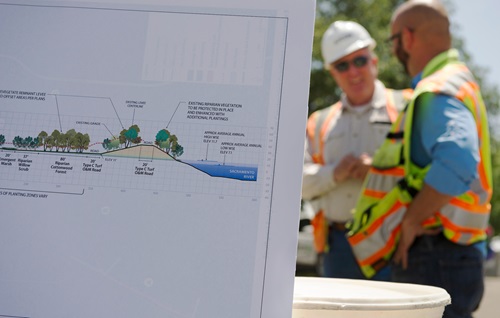Maintenance

The Southport Levee Improvement Project in West Sacramento, CA is a six-mile long project that will bring West Sacramento’s levees up to the state-mandated 200-year level of flood protection. DWR/2017.
We operate and maintain federally constructed flood control features in the Central Valley. We cooperate with the U.S. Army Corps of Engineers to repair flood-damaged federal flood control projects maintained under the authority of the Central Valley Flood Protection Board, which include levees, channels, and various flood control structures. To maintain the system, we plan, inspect, coordinate and permit environmental work, and design and construct repairs.
We also inspect levees within the State Plan of Flood Control (SPFC) to ensure maintenance and management obligations are met. We work with local levee maintaining agencies to meet Public Law 84-99 (PL 84-99) compliance standards.
In addition to our inspections, we repair and rehabilitate SPFC levees and flood control facilities. Through various state and federal programs such as the Sacramento River Bank Protection Project, Flood System Repair Project and PL 84-99, we work with other state, federal and local interests to inspect, evaluate, permit, design, and construct repairs for levee deficiencies that fall outside of routine maintenance.
Environmental Initiatives
When maintaining channels, levees, and flood control structures, we comply with state and federal environmental laws and regulations, including:
- California Environmental Quality Act
- California Endangered Species Act
- Federal Endangered Species Act
- Federal Clean Water Act
We are incorporating the 2017 Central Valley Flood Protection Plan Update's Conservation Strategy in our work, while streamlining permitting processes and coordinating with the regulatory agencies involved in all flood maintenance activities.
Aquatic Pesticide Application Plan
The Aquatic Pesticide Application Plan is being updated to include the potential use of additional State approved aquatic herbicides. The herbicides listed may be used by the Department of Water Resources Sutter Maintenance Yard (DWR-SMY) on an annual basis as needed to control vegetation in their maintenance areas. Vegetation control is needed along collecting canals that lead to pumping plants and where flow restriction may occur in the flood system. The main target of the herbicide applications is to address excessive primrose and parrot-feather blooms that impact water conveyance. The attached map illustrates the channel maintenance areas under the responsibility of DWR-SMY.
